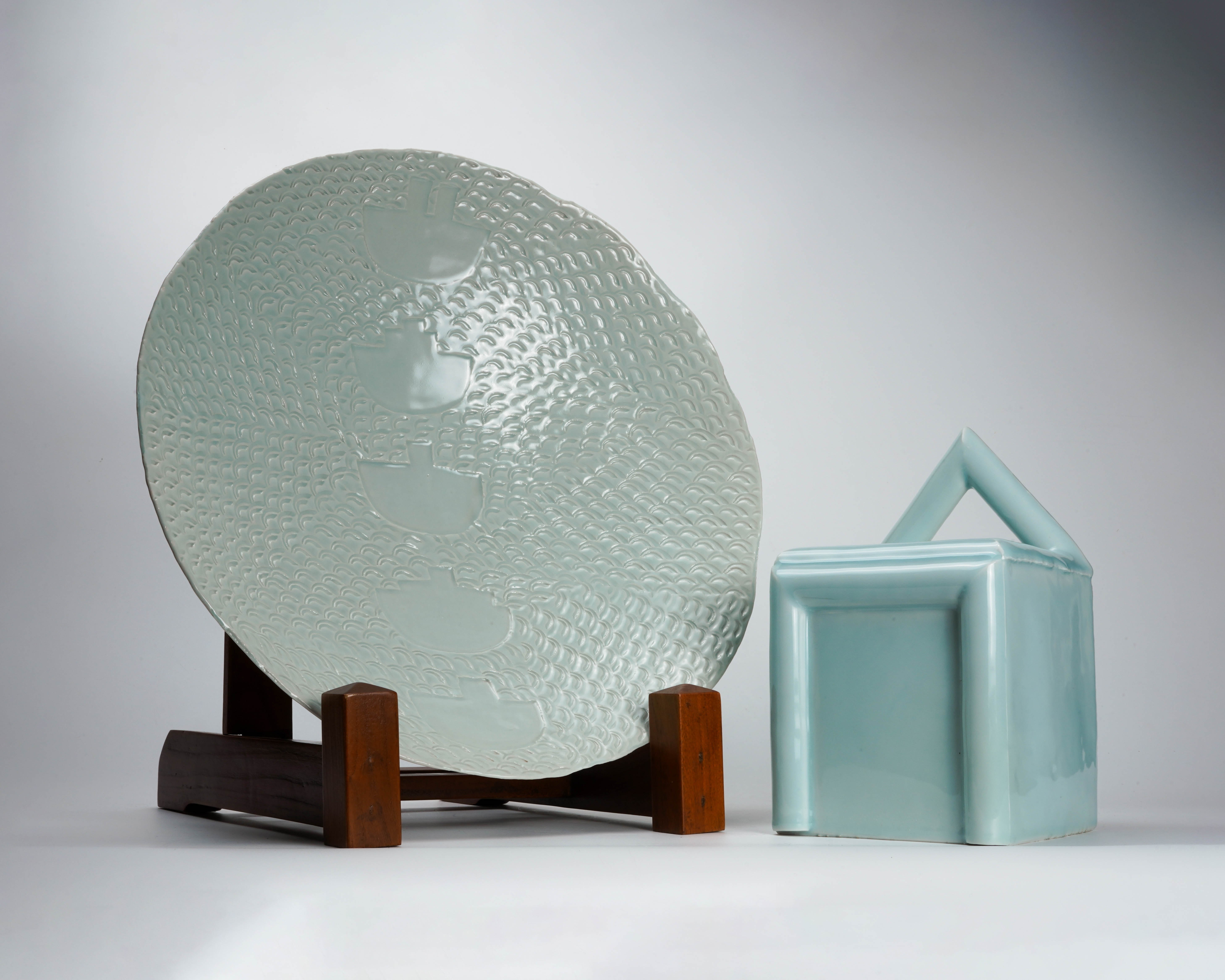
Born in 1936 on Kyoto’s Gojo-zaka Street, a district known for its long-standing association with Kiyomizu-yaki pottery, Suzuki Osamu (1926-2001) entered the world of ceramics through inheritance. As the third son in a family of wheel-throwing potters, Suzuki was immersed from childhood in the technical and cultural traditions of Kyoto ware. After graduating from the Kyoto City Second Technical School’s Ceramics Department in 1943, he initially followed the path laid out before him, working with functional vessels shaped on the wheel, as his father had done before him.
Suzuki’s trajectory soon diverged from family tradition. In 1947, he joined the Seinen Sakutoka Shudan (Group of Young Ceramic Artists), a Kyoto-based collective of emerging potters seeking new directions. There, he encountered Yagi Kazuo and Yamada Hikaru, two similarly restless figures in this new and radical generation of ceramicists who were also questioning the role of ceramics and crafts in a modernizing Japan. The following year, the three artists co-founded Sōdeisha (走泥社, "Crawling Through Mud Society"), an avant-garde movement that rejected both utilitarian ceramics and the rustic naturalism of folk craft. With Sōdeisha, Suzuki began to explore sculptural form and challenge the inherent limitations of the wheel. “In the beginning, I think I purposely chose shapes that were not an accumulation of circles,” he later reflected.
 Two works by Suzuki Osamu | Browse available works here
Two works by Suzuki Osamu | Browse available works here
His early influences included Kyoto-ware masters like Ninsei and Kenzan, as well as imported Cochinchina and Sometsuke wares. A more profound impact came from his encounter with Chinese Song dynasty ceramics and Korean porcelain. These refined objects, subtle in form and restrained in glaze, left him feeling like an “ignorant potter.” This moment of self-doubt sparked a new and transformative curiosity that would come to define his mature work.
In 1971, Suzuki turned to celadon (seiji), inspired by a longstanding admiration for Song ware. He found the medium delicate, refined, and technically demanding. Unlike red clay or stoneware, celadon that is thinly glazed and fired at high temperatures required a precision that appealed to his increasingly exacting sensibility. Still, he approached the material with humility. “Though I do not know if I am fit or prepared to work with celadon,” he once said, “I wonder if this glaze will escort me out of the stagnant situation I am in.”
During the Showa 40s (1965–1975), coinciding with the Osaka Expo era, Suzuki finally acquired the gas (or possibly wood-fired) kiln he had long desired. This allowed him to pursue a very specific vision for celadon: a pure, translucent blue known as inchin (影青), free from any hints of green or yellow. Unlike many of his contemporaries, he worked exclusively with porcelain to achieve the luminous clarity of seihakuji (青白磁), the pale blue-white glaze favored in Chinese ceramic tradition. He once distinguished his choice by stating, “Pottery (dirt) is a chipped form. Porcelain is an added form.” In his hands, porcelain became the medium through which surface, structure, and vision came into alignment.
Alongside his material experimentation, Suzuki developed a sculptural philosophy grounded in form. A pivotal moment occurred in 1954 when he encountered an exhibition of mud figures that altered his sense of three-dimensionality. From then on, he began to create abstract sculptural objects—horses, birds, and later symbolic figures—formed not from observation, but from internal synthesis. As critic Kaneko Kenji described, Suzuki would first imagine a shape inspired by accumulated memories of animals, then allow that image to evolve organically through the construction process. The resulting works were not straightforward representations, but embodiments of conceptual transformation.
This approach led Suzuki to formulate a theory of Deishō (泥象), a term he coined to articulate the tension between appearance (象, “what the eye sees”) and mental conception (像, “what the person envisions”). He felt that terms like objet-yaki, used by Yagi to describe non-functional works, diluted the conceptual depth behind their practices. Deishō, by contrast, emphasized the imaginative and philosophical underpinnings of form.
A compelling example of this concept appears in Suzuki’s Buddhist Priest (僧形), a porcelain sculpture that is both architectural and symbolic. At first glance, it appears as a simple geometric object: a cube-shaped base with thick, protruding lines extending upward to form a sharp isosceles triangle. The celadon glaze pools and stretches across the surface, revealing the white porcelain beneath in places and creating subtle tonal variations. While the form is abstract, it contains visual cues drawn from Buddhist iconography. The triangular top suggests a takuhatsugasa, the bamboo hat worn by monks, while the vertical framing lines resemble the wagesa, a cloth collar that symbolizes devotion. The overall shape also recalls the sunbōshi, a distinctive monk’s hat seen in Noh theater.

Image of a contemporary Noh performer. Learn more about Noh theatre here.

A Buddhist monk wearing a takuhatsugasa.
In this work, Suzuki uses celadon not simply as a surface treatment but as a medium for reflection. The soft, blue-green glaze invites quiet contemplation, transforming the figure of the priest into a meditative presence. The work suggests that Suzuki’s engagement with celadon was not only technical, but also personal. It became a metaphor for his own path: an inward journey informed by tradition, and principled introspection.
Suzuki Osamu’s legacy lies in his technically refined works that represent his manifestation and synthesis of concept. He worked with inherited materials and forms, yet refused to be confined by convention. His celadon sculptures beckon viewers to think. By giving shape to thought itself, Suzuki redefined what ceramics could be.
